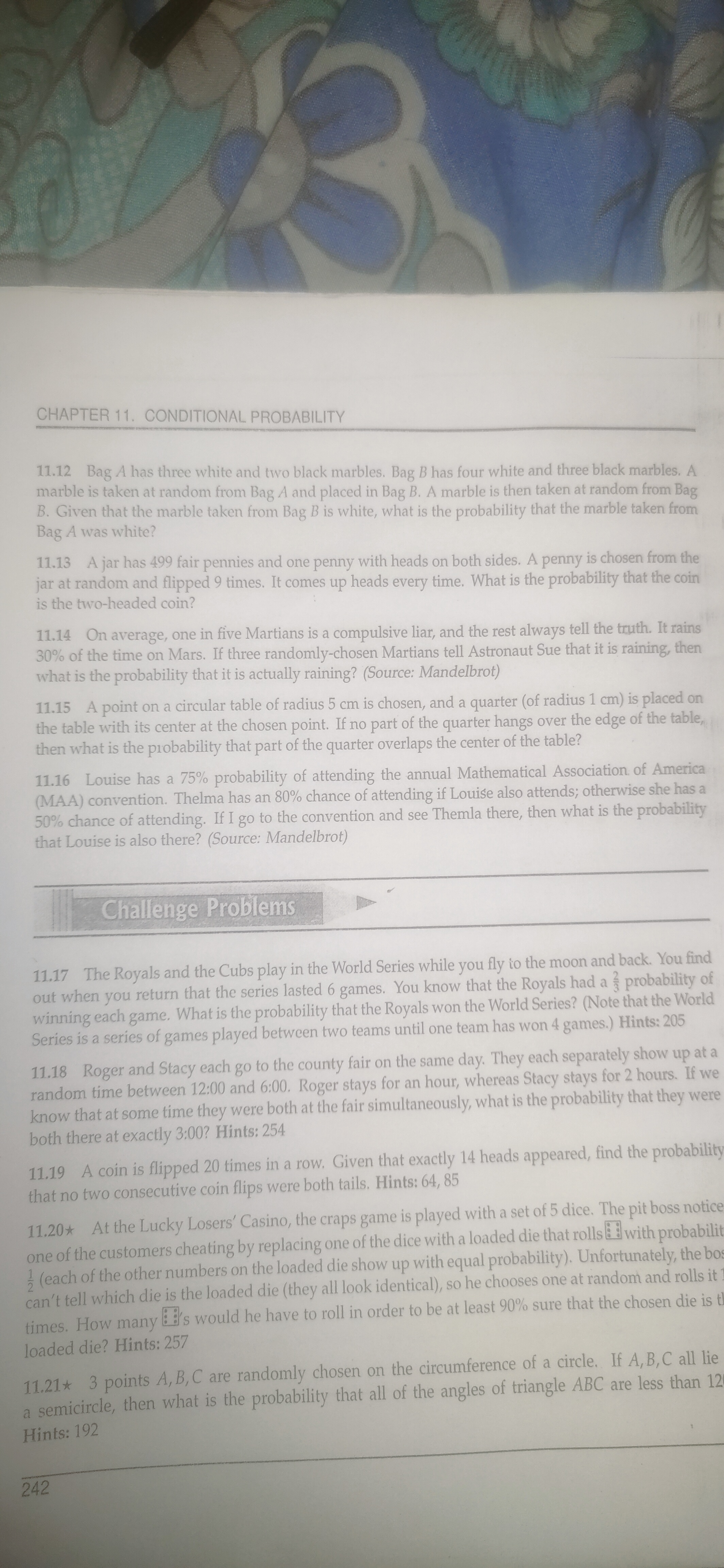Bag A has three white and two black marbles. Bag B has four white and three black marbles. A marble is taken at random from Bag A and placed in Bag B. A marble is then taken at ran... Bag A has three white and two black marbles. Bag B has four white and three black marbles. A marble is taken at random from Bag A and placed in Bag B. A marble is then taken at random from Bag B. Given that the marble taken from Bag B is white, what is the probability that the marble taken from Bag A was white?

Understand the Problem
The question describes various probability problems, asking for the likelihood of certain outcomes in scenarios involving marbles, coins, and dice. Each problem has specific parameters and requirements for determining the probabilities involved.
Answer
The probability is $\frac{15}{19}$.
Answer for screen readers
The probability that the marble taken from Bag A was white, given that the marble taken from Bag B is white, is $\frac{15}{19}$.
Steps to Solve
- Define the events and probabilities
Let:
- Event W: A white marble is drawn from Bag B.
- Event W_A: A white marble is drawn from Bag A.
The total outcomes to consider stem from which marble is drawn from Bag A and placed in Bag B.
- Calculate probabilities of transferring marbles from Bag A to Bag B
The possibilities for transferring a marble from Bag A to Bag B are:
-
Probability of transferring a white marble ($P(W_A)$): $$ P(W_A) = \frac{3}{5} $$ (3 white marbles out of 5 total marbles in Bag A)
-
Probability of transferring a black marble ($P(B_A)$): $$ P(B_A) = \frac{2}{5} $$ (2 black marbles out of 5 total marbles in Bag A)
- Determine Bag B compositions after transfer
- If a white marble is transferred:
- Bag B has 5 white and 3 black marbles.
- If a black marble is transferred:
- Bag B has 4 white and 4 black marbles.
- Calculate probabilities of drawing a white marble from Bag B
-
Probability of drawing white from Bag B if a white was transferred ($P(W | W_A)$): $$ P(W | W_A) = \frac{5}{8} $$ (5 white marbles out of 8 total)
-
Probability of drawing white from Bag B if a black was transferred ($P(W | B_A)$): $$ P(W | B_A) = \frac{4}{8} = \frac{1}{2} $$ (4 white marbles out of 8 total)
- Use the law of total probability to find $P(W)$
Calculate total probability of drawing white marble from Bag B: $$ P(W) = P(W_A) \cdot P(W | W_A) + P(B_A) \cdot P(W | B_A) $$ Substituting the known values: $$ P(W) = \left(\frac{3}{5} \cdot \frac{5}{8}\right) + \left(\frac{2}{5} \cdot \frac{1}{2}\right) $$ $$ P(W) = \frac{15}{40} + \frac{4}{40} = \frac{19}{40} $$
- Use Bayes' theorem to find $P(W_A | W)$
Now, we can find the conditional probability: $$ P(W_A | W) = \frac{P(W | W_A) \cdot P(W_A)}{P(W)} $$ Substituting the values we have calculated: $$ P(W_A | W) = \frac{\left(\frac{5}{8}\right) \cdot \left(\frac{3}{5}\right)}{\frac{19}{40}} $$ $$ P(W_A | W) = \frac{\frac{15}{40}}{\frac{19}{40}} = \frac{15}{19} $$
The probability that the marble taken from Bag A was white, given that the marble taken from Bag B is white, is $\frac{15}{19}$.
More Information
This problem exemplifies the use of conditional probability and Bayes' theorem, which are often applied in scenarios where the outcome depends on previous events. This analytical approach is valuable in fields such as statistics, finance, and decision-making.
Tips
- Neglecting to account for both scenarios: Students may forget to consider both cases of transferring a white or black marble when calculating the probabilities for Bag B.
- Misapplying Bayes' theorem: Incorrectly substituting probabilities instead of calculating conditional probabilities might lead to wrong outcomes.
AI-generated content may contain errors. Please verify critical information